#Pteranodon longiceps
Explore tagged Tumblr posts
Text

A while ago I (digitally) painted this Pteranodon longiceps, pretty proud of it! I used a skeletal and a photo of a sea bird on the beach as references.
#drawing#art#paleoart#paleo art#pterosaur#pteranodon#Pteranodon longiceps#beach#sunset#digital painting
171 notes
·
View notes
Text
Archovember 2024 Day 25 - Pteranodon longiceps
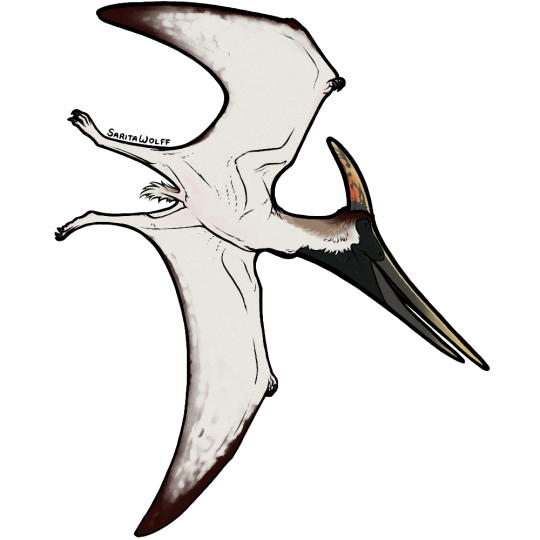
As one of the main species to make up the mythical “Pterodactyl” conglomerate, Pteranodon longiceps is possibly the most familiar pterosaur to the public. However, most people don’t know much about the real animal behind the pop culture monster. Living in the Late Cretaceous USA, Pteranodon is also the most well-known pterosaur to science, as over 1,200 specimens have been found! It was the first pterosaur found outside of Europe, the first toothless pterosaur found, and, before the discovery of the giant azhdarchids, was also the largest pterosaur known. Pteranodon is also one of the few prehistoric animals with confirmed sexual dimorphism, and it’s a bit extreme to boot! The larger male Pteranodons had huge pointed crests and an average wingspan of 5.6 m (18 ft), while the smaller female Pteranodons had small, rounded crests, wider pelvic canals, and an average wingspan of 3.8 m (12 ft).
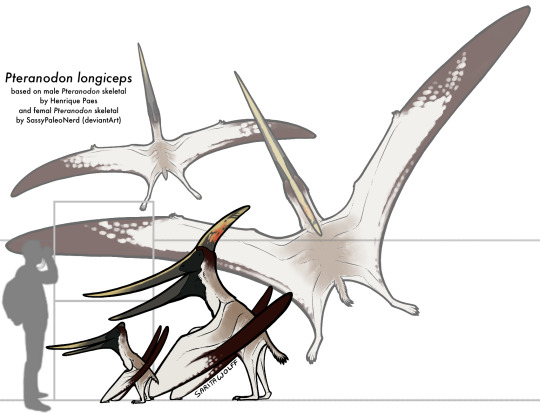
Pteranodon lived around the Western Interior Seaway, a massive sea that split North America in two during the Late Cretaceous into the Early Paleocene. With wings shaped like modern day albatrosses, Pteranodons were likely gliders who relied on thermals, but did seem to be more capable of sustained flapping. As one would expect, their diet was made up mostly of fish, though they may have eaten invertebrates as well. With their more heavy build, they could probably dive into the water like modern day gannets, folding up their wings and plunging beneath the waves, snatching up fish with their pointed, birdlike beaks. Pteranodon crests were most likely for display, as there was variation between not only males and females, but also individual males. As females were twice as common as males, they were probably polygynous, with males competing for the mating rights in rookeries of females. Competition was likely not physical, and instead would depend on females determining the age and fitness of males based on the size of their crest.
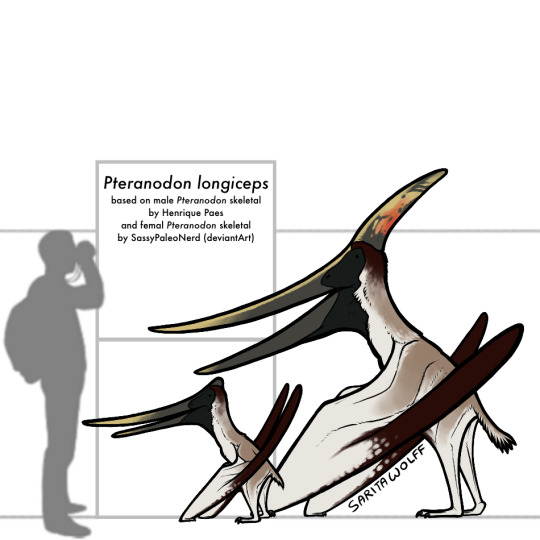
Pteranodon has been found in both the Niobrara Formation and the younger Pierre Shale Formation. Some possible fragments from the Mooreville Formation and Merchantville Formation also exist. While Pteranodon was much more common, it would have lived alongside, and possibly competed with, the fork-crested pterosaur Nyctosaurus and the toothed seabird Ichthyornis. It is probable that Pteranodon lived in offshore rookeries, raising their flaplings far from land-based predators, as most fossils are found far from what would have been the Interior Seaway’s coastline. Under the waves, Pteranodon would have hunted a variety of fish, ammonites, and squid. It would have come across sea turtles such as Toxochelys, plesiosaurs such as Styxosaurus, and flightless birds like Parahesperornis. It would have had to look out for mosasaurs like Tylosaurus and sharks like Cretoxyrhina. Aside from birds, most Pteranodons would rarely come across dinosaurs. Their main exposure to dinosaurs would be corpses, like that of the hadrosaur Claosaurus, being swept out to sea.
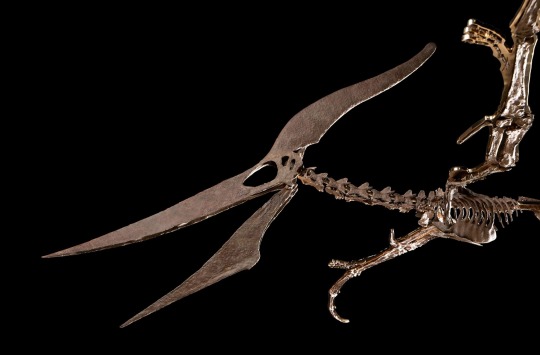
This art may be used for educational purposes, with credit, but please contact me first for permission before using my art. I would like to know where and how it is being used. If you don’t have something to add that was not already addressed in this caption, please do not repost this art. Thank you!
#Pteranodon longiceps#Pteranodon#pteranodontid#pterosaurs#archosaurs#archosauromorphs#reptiles#Archovember#Archovember2024#Dinovember#Dinovember2024#SaritaDrawsPalaeo#Late Cretaceous#USA#Niobrara Formation#Pierre Shale Formation#Mooreville Formation#Merchantville Formation
41 notes
·
View notes
Text

sames same
12 notes
·
View notes
Text

The Pizza Knight Saves The Princess is a fantasy-comedy choose-your-own-adventure-style visual novel being developed by Dragon's Den Studios. Set on the planet Comestibla, where everything & everyone is made of food, we play as the Pizza Knight as he tries to save his beloved Water Ice Princess from the castle of the evil Chocolate Count. You can download the demo for free HERE: https://dragons-den-studios.itch.io/the-pizza-knight-saves-the-princess
Over the course of this month I'll be posting some of the game's art to this blog! This image is a sneak peak of content only available in the full release!
This image depicts a flashback that the Pizza Knight has to his youth after drinking one of the potions. This memory, taking place ten years before canon, depicts a scene from the knight's years as apprentice knight to the Skim Milk Knight when they visited the inn of Flying Jacob, a veteran of the AU wars made from, well, Flying Jacob (a Swedish casserole made from chicken, cream, chili sauce, bananas, roasted peanuts, and bacon). While the Skim Milk Knight talks of bygone days with his host, the Pizza Knight encounters one of Flying Jacob's tamed Pteranodonuts, who is begging for a sample of the knight's lingonberries. The sodas in the foreground are based on a discontinued line of sodas from Sweden called Kristall that I loved as a kid, particularly their pear flavor.
#dragon's den studios#the pizza knight saves the princess#the pizza knight#the skim milk knight#flying jacob#medieval fantasy#well sort of they're industrializing#visual novel#indie games#indie game dev#pizza#skim milk#casserole#frosted donut#pteranodonut#pteranodon#Pteranodon longiceps#flashback#great offscreen war#soda#lingonberry
5 notes
·
View notes
Text
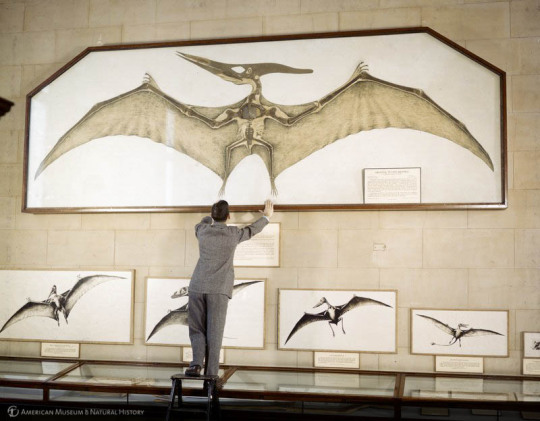
It’s a bird! It’s a plane! It’s… a dinosaur? Nope to all of the above. This Fossil Friday, let’s talk about pterosaurs—the first animals with bones to evolve powered flight. Though they were related to dinosaurs, pterosaurs evolved on a separate branch of the reptile family tree. They ruled the skies for more than 150 million years, evolving into dozens of different species. Some were as small as a paper airplane while others, like Pteranodon pictured here in the Museum's Hall of Late Dinosaurs circa 1940-1960, had a wingspan of more than 20 ft (6 m).
Along with other large pterosaurs, Pteranodon longiceps was first discovered in western Kansas, near a chalk formation called Monument Rocks. Today the region is dry, but at the time this species lived, about 85 million years ago, central North America was covered by a seaway. This large pterosaur likely spent its days flying over the sea. Unlike early species of pterosaurs, Pteranodon and many other Cretaceous-era species didn’t have any teeth. In fact, its genus name means “winged and toothless,” while the second name, longiceps, means “long-headed.”
Today, you can find Pteranodon in the Hall of Vertebrate Origins. We're open daily from 10 am-5:30 pm! Plan your visit.
Photo: Image no. ptc-217 © AMNH Library
#science#amnh#museum#dinosaur#fossil#nature#natural history#paleontology#animals#pterosaur#reptile#did you know#fact of the day#ancient animals#prehistoric animals#vertebrates#fossil friday#pteranodon#archives#flashback friday
668 notes
·
View notes
Text
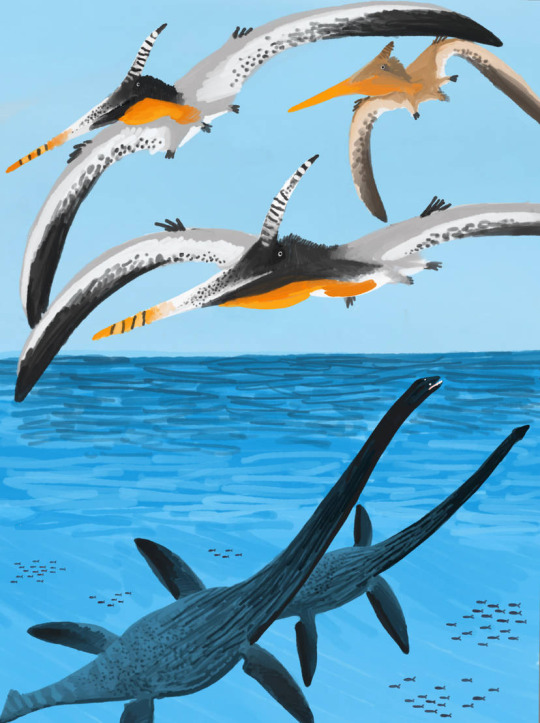
Two male and one female Pteranodon longiceps soar over the heads of a pair of Styxosaurus browni 85 million years ago in what is now the Niobrara Formation of Kansas
#paleoart#paleontology#pteranodon#pterosaur#plesiosaur#niobrara chalk formation#campanian#styxosaurus#cretaceous period#late cretaceous
449 notes
·
View notes
Text

Archovember day 25! Pteranodon longiceps! A Pterosaur from the late Cretaceous! I still remember when I found out that there were flying animals during the time of the dinosaurs. Feel like Ive said that before... either way it remains true that Pterosaurs of all kinds capture my imagination.
34 notes
·
View notes
Text
actually wait i have another (her name is violet)

Ok but IMAGINE if we started taking more inspiration from weird birds when designing dinosaurs. Give me velociraptor with a peacock plume. Give me Trex with a big, red comb and wattle. Give me Spinosaurus with iridescent duck feathers and big, webbed feet (they're still aquatic, right?). Pterosaurs with bald vulture heads. Archaeopteryx with the most insane mating dances on par with weaver birds and birds of paradise.
Just more weird bird dinosaurs, please
417 notes
·
View notes
Text

Paleovember 2023, Pteranodon longiceps! One of the most famous pterosaurs, this animal once held the title of the largest known flying animal ever (until the discovery of azhdarchids) with its 18 foot wingspan. Males were nearly double the size of females, indicating that their social structure was based around a single male with his harem of females.
#pteranodon#late cretaceous#pterosaur#paleontology#paleoart#Paleovember#mesozoic#animal#illustration#art#artwork#digitalart#drawing#creaturedesign#procreate#artist on tumblr
87 notes
·
View notes
Text

Skull of Pteranodon longiceps from A Guide to the Fossil Reptiles and Fishes in the Department of Geology and Paleontology in the British Museum (Natural History), 1896.
3 notes
·
View notes
Note
so when you say one of the zords is a pterodactyl, do you mean this funky guy?

this is Pteranodon Longiceps, and is usually what comes to mind when someone says "pterodactyl", which is a pop culture catch all term for pterosaurs
but there IS a pterodactylus! that's this silly goober

I ask because Pterodactylus is technically the "pterodactyl" but they were also so tiny

im sorry im such a paleo nerd i just gotta infodump when i can

I guess the first one...?
Listen bro, they called the Mastodon and Saber-Tooth Tiger zords "dinozords" so dont expect much from MMPR lmao
3 notes
·
View notes
Text

Archovember is here once again! Looooots of theropods this year. Also a lot more dinosaurs in general than other archosaurs. Sorry. There were just too many I wanted to add!
I also apologize that there are several redraws in this list… I included a couple animals I’ve drawn for past Archovembers that I wasn’t quite happy with (7 to be exact, oop). If you’ve been drawing along since the beginning and don’t feel like drawing a repeat, feel free to substitute a related species!
For new folks: this is my “Draw Dinovember” list that I expanded out to include other archosauriforms. I started doing this a few years ago to challenge myself to draw species I’ve never drawn before and/or ones that don’t get a lot of attention. Feel free to join in! You can do the whole list, just the dinosaurs (the names in green), just the pterosaurs (orange), just the pseudosuchians (blue), just the 3 oddballs (red), just your favorites, just ones you’ve never drawn before, pick one blindly, roll a D20 and a D10 and draw the sum of whichever numbers you get, etc. Just make sure they’re posted on or after their specific day! You can use #Archovember or #Archovember2024, as those are the tags I follow. Be as detailed or as sketchy as you’d like! I’ll be leaving the story highlights on my Instagram (also SaritaPaleo) from last year’s Archovember up until November 1st, if you’d like to see what people have done in the past! (This challenge usually gets a lot more traction on Instagram; so I would recommend checking it out there if you have one!)
As a disclaimer that I am obligated to give every year: when you are looking for refs for some of these species you will come across David Peters. This guy posts a lot of pseudoscientific images featuring lesser-known species, and his stuff can sometimes dominate search results. Do not trust anything from sites called “Reptile Evolution” or “The Pterosaur Heresies.” Peters’ constant outpouring of material has a habit of clogging up search results, misleading and tripping up people who may be trying to get into paleoart. He fooled me when I was first starting out! If you’re drawing along and are having trouble finding legit references, send me a message and I can send you what I’m using!
Anyway, here is the list in case the above graphic can’t be read:
1. Your Choice!
2. Other - Protorosaurus speneri
3. Dinosaur - Gorgosaurus libratus
4. Pterosaur - Preondactylus buffarinii
5. Dinosaur - Gargoyleosaurus parkpinorum
6. Pseudosuchian - Razanandrongobe sakalavae
7. Dinosaur - Vespersaurus paranaensis
8. Other - Euparkeria capensis
9. Dinosaur - Spiclypeus shipporum
10. Pterosaur - Arambourgiania philadelphiae
11. Dinosaur - Tsintaosaurus spinorhinus
12. Pseudosuchian - Armadillosuchus arrudai
13. Dinosaur - Shingopana songwensis
14. Pterosaur - Cuspicephalus scarfi
15. Dinosaur - Saturnalia tupiniquim
16. Pterosaur - Caelestiventus hanseni
17. Dinosaur - Koreaceratops hwaseongensis
18. Pseudosuchian - Lotosaurus adentus
19. Dinosaur - Pelagornis sandersi
20. Pterosaur - Anurognathus ammoni
21. Dinosaur - Jakapil kaniukura
22. Pseudosuchian - Purussaurus brasiliensis
23. Dinosaur - Ledumahadi mafube
24. Pseudosuchian - Sillosuchus longicervix
25. Pterosaur - Pteranodon longiceps
26. Dinosaur - Compsognathus longipes
27. Other - Tanystropheus longobardicus
28. Pseudosuchian - Eurycephalosuchus gannanensis
29. Pterosaur - Campylognathoides zitteli
30. Dinosaur - Iguanodon bernissartensis
66 notes
·
View notes
Note
TRICK OR TREAT

Pteranodon longiceps, the biggest pterosaur before they found Quetzalcoatlus
11 notes
·
View notes
Text

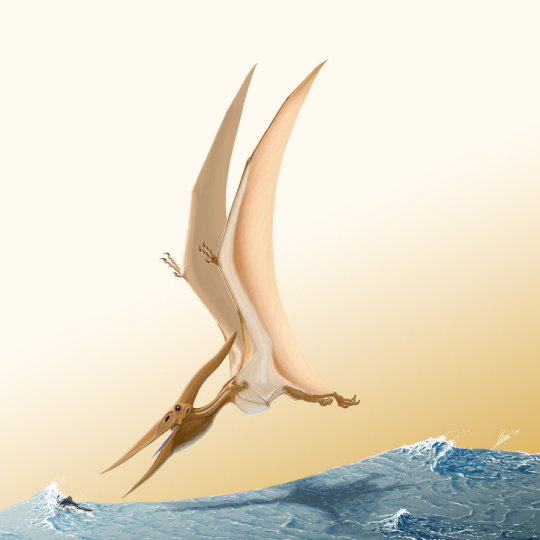
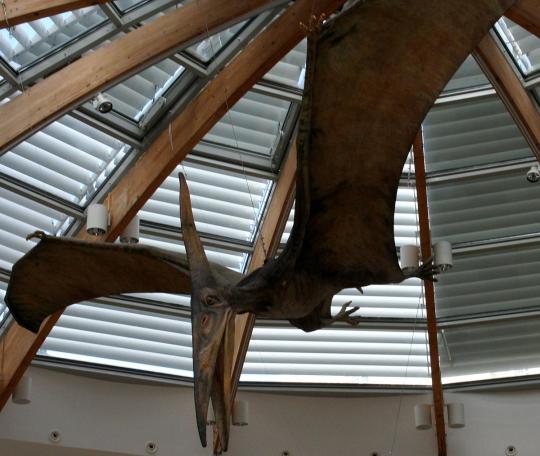
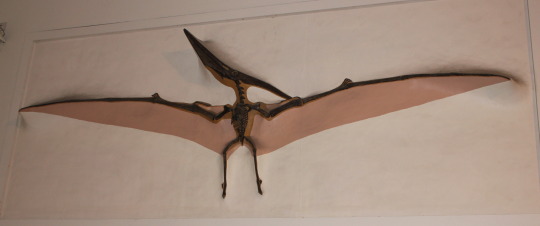
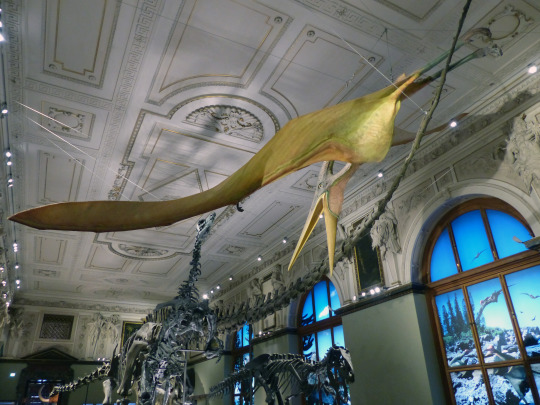
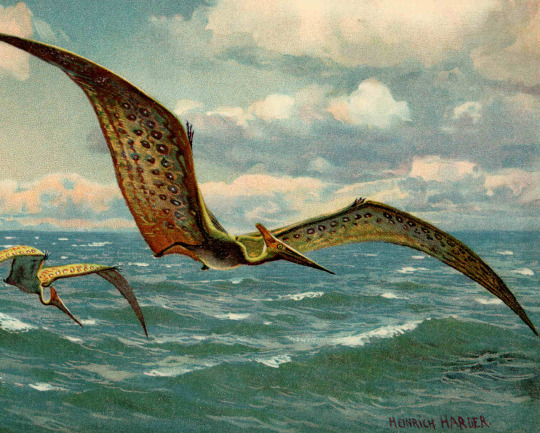
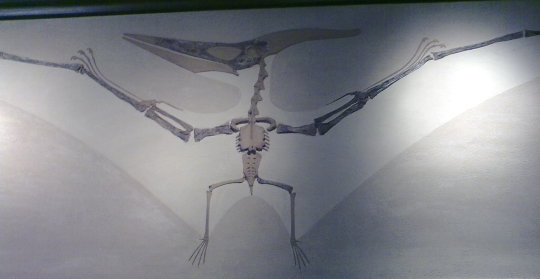

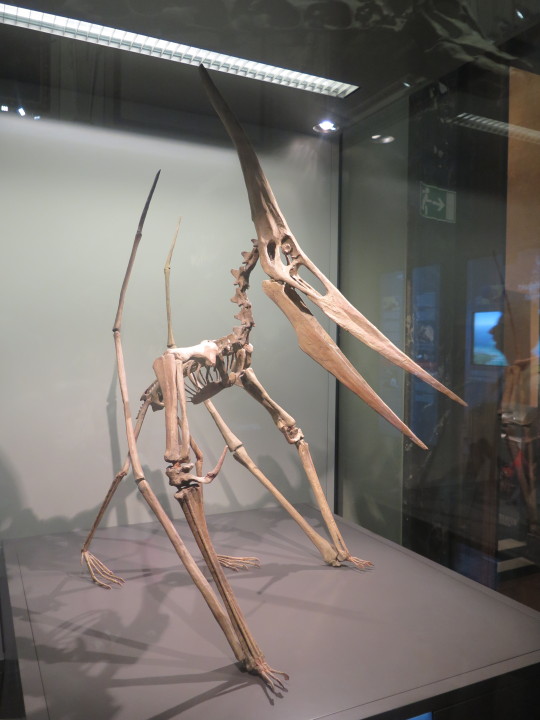
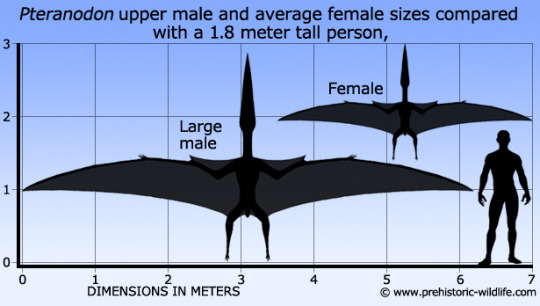
Pteranodon
(temporal range: 86-84.5 mio. years ago)
[text from the Wikipedia article, see also link above]
Pteranodon (/tɪˈrænədɒn/); from Ancient Greek πτερόν (pteron 'wing') and ἀνόδων (anodon 'toothless') is a genus of pterosaur that included some of the largest known flying reptiles, with P. longiceps having a wingspan of over 6 m (20 ft). They lived during the late Cretaceous geological period of North America in present-day Kansas, Nebraska, Wyoming, South Dakota and Alabama.[1] More fossil specimens of Pteranodon have been found than any other pterosaur, with about 1,200 specimens known to science, many of them well preserved with nearly complete skulls and articulated skeletons. It was an important part of the animal community in the Western Interior Seaway.[2]
Pteranodon was not a dinosaur. By definition, all dinosaurs belong to the group Dinosauria; Pteranodon belongs to the group Pterosauria. Nonetheless, Pteranodon is the most famous pterosaur, frequently featured in dinosaur media and strongly associated with dinosaurs by the general public.[3] While not dinosaurs, pterosaurs such as Pteranodon form a clade closely related to dinosaurs as both fall within the clade Avemetatarsalia.
4 notes
·
View notes
Text
Pteranodon for sure! "Pterodactyl" is technically for Pterodactylus antiquus, a relatively small pterosaur from late Jurassic Europe.

(Image by Matt Martyniuk)

(image by Julio Lacerda)
whereas Myfanwy is likely a Pteranodon, a much larger pterosaur from Cretaceous North America. Myfanwy appears to be P. Longiceps (the dudes with the long bony crests) specifically.

(Image by Matt Martyniuk)

(Image by Mark Whitton)
Had the show been a bit truer to science, Myfanwy would also likely be very fond of fish!
so my post about the torchwood office pet pterodactyl may have breached containment and i have been educated more on her!
her name is myfanwy and i’ve seen somebody say that she isn’t a pterodactyl because she’s too big and should actually be labelled as a pteradon instead (though they still call her a pterodactyl in the show)
#torchwood#haven't watched that wacky show in forever#i miss it#thanks for the opportunity to infodump on my favorite group of prehistoric beasties
52 notes
·
View notes
Text

Beautiful Creatures
What’s this? Another revision to my take on Pteranodon? Why yes it is!
I’ve been practicing drawing pterosaurs a lot lately! I’m still struggling with the wings specifically but I think I’m getting closer and closer to a style I have a real fondness for!
I want them to be as plausible as possible. This image, based on a Mark Witton skeletal (one that can be found here) shows a male (the large one with the long, brightly colored crest) and a female (the smaller one with the short, black crest) launching.
Heavily inspired by modern birds that display similar dimorphism, I gave the male a more vibrant palette, with reddish brown fur, while the female is a regular shade of brown and has some cryptic coloration going on. They also both have little black “masks” over their eyes. Why? Honestly just cause I felt like it lol.
I hope y’all enjoy!
#my art#paleoart#pterosaur#pterosaurs#pteranodon#pteranodon longiceps#NOT A DINOSAUR#paleontology#paleoillustration
13 notes
·
View notes